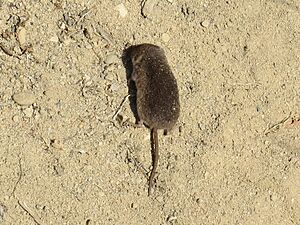Vagrant shrew facts for kids
Quick facts for kids Vagrant shrew |
|
|---|---|
 |
|
| Conservation status | |
| Scientific classification | |
| Genus: |
Sorex
|
| Species: |
vagrans
|
 |
|
| Vagrant shrew range | |
The vagrant shrew (Sorex vagrans), also known as the wandering shrew, is a small, busy animal found in North America. It's a type of shrew, which looks a bit like a mouse but is actually more closely related to moles. Long ago, some other shrews were thought to be the same species as the vagrant shrew.
Where They Live
These shrews live in open areas and forests in western Canada and the United States. You can find them west of the Continental Divide, which is a line of high mountains that separates rivers flowing to different oceans.
In Canada, they live in southern British Columbia, including Vancouver Island. They are also found as far east as the very southwestern part of Alberta. In the United States, they are common in most of Washington, Oregon, and Idaho. They also live as far south as central California, and in parts of Nevada, Utah, Montana, and Wyoming.
Vagrant shrews like wet places like grasslands and meadows. They can live in cold mountain areas called tundra or in wet swamps. They are often found near rivers or other water sources. They also live in open pine forests, but rarely in very thick woods. These shrews often use fallen logs for cover, so they like areas with some woody debris.
There are three types of vagrant shrews, called subspecies:
- Sorex vagrans halicoetes - lives in salt marshes in central California.
- Sorex vagrans paludivagus - lives along the central California coast.
- Sorex vagrans vagrans - lives in all the other areas where vagrant shrews are found.
What They Look Like
Vagrant shrews are usually reddish-brown with white or gray fur on their bellies. However, shrews living near the coast can be much darker, almost black on their backs. They have a long tail that is sometimes lighter underneath, especially when they are young.
These shrews look similar to other shrews in the same areas. But you can tell them apart because the vagrant shrew is smaller than the montane shrew and has a shorter tail. It also has fewer special pads on its back feet. It's harder to tell them apart from Trowbridge's shrew without looking closely at their skulls. Trowbridge's shrews also tend to have a more noticeably pale underside to their tails when they are adults.
In winter, their fur turns dark brown. They change their fur (molt) in the fall, usually between September and October. This change starts on their back and moves forward. Another change starts on their nose and moves backward. The spring molt is different for each shrew, so you might see shrews with both winter and summer coats at the same time for several months in spring and early summer.
A vagrant shrew's body is about 10 centimetres (3.9 in) (4 inches) long, including a 4 centimetres (1.6 in) (1.6 inches) tail. Adult shrews weigh between 4 to 8 grams (0.14 to 0.28 oz) (0.14 to 0.28 ounces). Males are usually a little bigger than females. These shrews have a very fast metabolism, meaning their bodies burn a lot of energy quickly. They don't seem to slow down or go into a deep sleep (torpor) during winter.
How They Live
Vagrant shrews mostly eat earthworms, spiders, insects, and other small creatures without backbones. They also eat some plants. Because they burn so much energy, they can eat more than 160% of their own body weight in food every day! Owls and even bobcats are some of their main predators.
They are active all day long, usually for short bursts of five to ten minutes before resting. However, they spend more time looking for food at night than during the day. Most of the year, they live alone, except during the spring breeding season. They defend their home areas, which are about 1,000 m2 (11,000 sq ft) (about a quarter of an acre). They do this by squeaking and making short charges at other shrews, but they rarely fight. During spring, their home areas become much larger, especially for males.
Most of the year, vagrant shrews build shallow, cup-shaped nests from plants and animal hair. These nests are about 8 cm (3.1 in) (3 inches) wide. In winter, they add a domed roof to their nests for more shelter. Females also build similar domed nests during the breeding season to raise their young. These nests are bigger than the winter nests, sometimes reaching 24 cm (9.4 in) (9.4 inches) across and 6 cm (2.4 in) (2.4 inches) high. Vagrant shrews sometimes use echolocation (like bats do, using sound to "see") to find their way around in new places. However, they probably don't use it to find their food.
They often use paths that voles have made.
Life Cycle and Young
Vagrant shrews usually have babies between April and June. However, babies can be born as early as February or as late as September. The mother carries the babies for twenty days. A litter usually has two to eight young shrews. A female can have up to three litters of babies each year.
When they are born, the young shrews are hairless and blind. They weigh less than 0.5 g (0.018 oz) (0.02 ounces) each. They grow very quickly in their first few weeks. They start to grow fur by two weeks old and open their eyes by three weeks. They stop drinking their mother's milk (are weaned) when they are between sixteen and twenty-five days old.
Most vagrant shrews live for a little over six months. However, some can live much longer. While few live for more than seventeen months, a small number can survive a second winter and reach two years of age.


